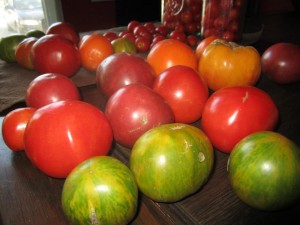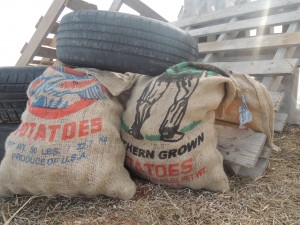Are you old enough to remember a time when people used to grow the majority of their own food, themselves? I’m not, but I have read about these glorious times. People only went to “grocers” for items they couldn’t produce themselves, like sugar, salt, vanilla and gluten-free coconut flour. (Just kidding on the last one.) But people really did rely on their family’s knowledge passed down through generations in order to provide enough food for their families for the entire year, EVERY year! That is quite a feat in today’s culture, where many of us know next to nothing about growing food. I have been reading Little House in the Big Woods to my son and there are some really strange food-related practices they do in that story. For example, when Pa is butchering the wild pig he shot in the big woods, he gets to the bladder, which is Laura’s favorite part, because they blow it up like a balloon and play ball with it!! Many kids today don’t even know that bacon comes from pigs, let alone that the bladder could be a toy.

Maybe you are interested in butchering your own swine. Maybe not. If not, you’ll be glad that this post is about things that grow in the ground, and figuring out how much of each item you need to grow to support your family. At least, that’s what I’m going to attempt to do for our first year of self-sufficiency at H.O.M.E. Farm. I’ll give you some sources to help you figure this out, plus some considerations I came up with while planning our garden.
In a previous post, How Much to Grow (Part 1), I explained how I determined how much of each food item we consumed in a year by saving all of our receipts. I have used that information, coupled with some other sources that I know you’ll find useful if you’re attempting to some day grow all your own food.
Those resources are:
- John Jeavon’s How to Grow More Vegetables (and Fruits, Nuts, Berries, Grains, and Other Crops) Than You Ever Thought Possible on Less Land Than You can Imagine. This book has been our bible during the planning phase, giving us spacing requirements, approximate yields, suggested companion plants, methods for bed preparation, and a wheelbarrow full of other practical information.
- Seed Catalogs and their respective websites. Even if you’re not purchasing seeds from a given company, you can get variety specifications like days-to-maturity, planting instructions, and heirloom information, like where that crop grows best.
- Your state Cooperative Extension Service usually has planting dates specific to your area, as well as frost dates and precipitation spikes. So much about gardening is site-specific so local sources are very valuable.
- Suzanne Ashworth’s Seed to Seed has all the details you could possibly need on saving seeds, such as isolation distances, seed collection techniques, region-specific planting information, and botanical information for a slew of vegetables. Saving seed is going to be an integral part for any homestead that seeks to minimize seed purchases.
- The web-browser of your choice. Any questions that will arise, and there will be many, can be answered by a quick search online. Do cucumbers cross with spaghetti squash? How tall do leeks get? How many tomatoes does the average family of four eat? These are real questions that I had that were answered by the almighty web of knowledge.
The Process:
I first looked at how much of each item we consumed last year and compared that with some other sources. Some items are more difficult to find than others. I put together this handy little table to illustrate the amounts consumed by the average American for some basic staple crops. Staple crops are those that can store easily, provide decent amounts of protein or other nutrients, and can be eaten on a regular basis.
The following table is per person and gives a range for how much should be grown for a year’s worth of food. You can simply average the amounts and multiply by the number of members in your family.
[table id=1 /]
Another way to guesstimate how much you need is to think about how often you want to eat a certain food. For example, we’d like to have beets as a side dish to a meal at least once a week. Figure that the side dish per person is a 1 cup serving, so we’d need 4 cups (about 6 beets) per week x 52 weeks in a year = 312 beets.
Here’s another example: 4 1-cup servings of carrots twice a week (either as a side or in a soup or pot-pie): 8 carrots per week x 52 weeks = 416 carrots.
One more example, a staple item, Dry Beans: Only a half-cup serving per person every other week = 2 cups per week x 26 weeks = 52 cups. There are 2 cups of dry beans per pound, so 26 pounds. (29 pounds was the average for a family of four from the table above).
Other things to consider when determining how many plants to plant:
Foods you Like: Radishes are easy to grow and store well. This does not mean I am planting 200 pounds of them. We LOVE Kale and Asian greens like Pak Choy and Mizuna, so we’re planting about 30 each in the spring and again in the fall.
Germination Rate: Many seed packets have a germination rate included on the package. If you’re needing to grow 100 onions, but the germination rate is only 75%, you would divide 100/.75 = 133. You would need to plant 133 seeds to get 100 onion plants.
Losses: Onions get moldy, cabbage and lettuces get eaten by rabbits. Dogs trample baby plants and high winds topple over corn and Jerusalem artichokes. We chose to up all of our plantings by 30% in this first year. In the following years, when we have a better idea of what to expect, we’ll up our plantings by, say 20%. It is wise to expect and prepare for losses.
Space: This is a big one for people in urban areas. I am not expert in square foot or container gardening, so you’ll have to look elsewhere for advice. There is plenty of it out there though. We are fortunate to have 10 acres to play with right now.
Seed Saving: After reading through Seed to Seed, I now know that the Brassicas are very difficult for the beginning seed saver. If you are planning on saving seed, you may need to limit the varieties of crops in the same family. For example, I would love to grow 3 different varieties of broccoli, and 5 different varieties of cabbage but because we’d like to save seed, we can only grow 1 of each and must do a technique called alternate day caging in order to save seed. This doesn’t mean you have to grow less food, just less varieties.
Storage: Do you have a dehydrator? A large capacity freezer? Have you canned your own veggies yet? Most crops that grow underground; potatoes, carrots, onions, beets, and garlic will store well as long as they are in a cool place i.e. a root cellar. Some veggies that freeze well are; broccoli, pumpkin (once cooked), cauliflower, and onion. But, if you are off-grid and don’t have a large freezer, trust me when I say that dehydrated broccoli is less than tasty. If we could store it all year long, I would plant way more watermelon, but I do not like dehydrated watermelon and it doesn’t freeze well either, so 6 watermelon plants is enough for this summer.
An Experienced Grower’s Advice: I’ll be honest here. For tomatoes, I am simply taking Barbara Kingsolver’s word for it when she says that 15 tomato plants are sufficient for her family of 4. This includes fresh and canned.
Once you have a list compiled of approximately how much you need to feed your family, all things considered, you can start doing some mapping. When you get the maps going, it’ll be really easy to visualize how much space it takes to provide for your family.
Here are a few of the numbers for my soon-to-be 4 member family:

Beans: About 200 plants, yield: about 25 pounds
Broccoli: 10 plants in spring, 10 in fall, yield: 20-30 heads
Cabbage: 15 plants
Onions: About 75
Peppers (sweet): 15 plants, yield: 45 peppers
Peppers (hot): 15 plants, yield: 300 peppers
Potatoes: 100 pounds, yield: 500 pounds
Pumpkin: 10 plants, yield: 10-20 pumpkins
Tomatoes: 15 plants, yield: 375 pounds
Beyond the considerations I have posed for you here, the most important one is to keep good records! Everyone is different. There are numerous varieties, ways to plant, and climatic variables which will make my yields different from yours. Also, you may love radishes and hate kale and thus, our garden plans will look very different. Keeping records makes you more aware of the variables in your area and climate.
Beyond keeping track of your yields with a scale at every harvest, other information to keep track of includes:
- Plant name and variety
- Seed company purchased from
- Rhizobium or other innoculant used
- How many you planted
- Other plants directly adjacent
- General notes about growth
- General notes about flavor
- Notes for next year’s planting, growth and harvest
Nothing can help you plan better for next year’s garden than last year’s notes! Every year will get easier and easier to plan for. This year, I hunkered down at the computer for a few hours a day to come up with all the numbers and maps for this growing season. Next year, I presume will take less time and require less Google searches. I will make an update to this post after the harvest to compare my guesstimates with reality. I hope this has helped in your garden planning! If you have any questions, remember I am no expert yet, but I can definitely try to find an answer for you. Happy Gardening!
*Resources:
Agricultural Marketing Resource Center: http://www.agmrc.org/commodities__products/vegetables/
Arizona Master Gardener Manual: http://cals.arizona.edu/pubs/garden/mg/vegetable/index.html
The Well-Fed Homestead: http://www.wellfedhomestead.com/how-much-should-you-plant-in-your-garden-to-provide-a-years-worth-of-food






